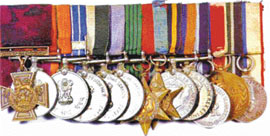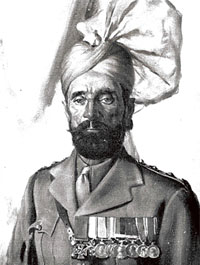
| Neuve-Chapelle Indian Memorial |
| Pas de Calais, France |

 Sub Khudadad Khan
Sub Khudadad Khan The battles on the Western Front in which the Indian Army took part: La Bassee 1914, Ypres 1914-15, Givenchy 1914, Aubers, Bazentin, Morval, Messines 1914, Gheluvelt, Neuve Chapelle, Loos, Delville Wood, Armentieres 1914, Festubert 1914-15, St Julien, Somme 1916, Flers-Courcelette and Cambrai 1917--- ''They shall grow not old, as we that are left grow old:
The battles on the Western Front in which the Indian Army took part: La Bassee 1914, Ypres 1914-15, Givenchy 1914, Aubers, Bazentin, Morval, Messines 1914, Gheluvelt, Neuve Chapelle, Loos, Delville Wood, Armentieres 1914, Festubert 1914-15, St Julien, Somme 1916, Flers-Courcelette and Cambrai 1917--- ''They shall grow not old, as we that are left grow old:
A moment of contemplation

The Mayor lays a wreath on behalf of the people of the city
Remembering their sacrifice
At midday on Sunday 26 September, a new war memorial, built by the Commonwealth War Graves Commission, was unveiled in close proximity to the Chattri Indian Memorial in Patcham. It is designed to pay tribute to some of the one and half million Indian soldiers who fought for the British Empire during the First World War. The new memorial bears the names of 53 Indian soldiers who died in Brighton and were cremated on the site of the Chattri memorial.
In memory of those Indian Soldiers who who fought and
died so far away from their Country----
YOU WILL NEVER BE FORGOTTEN





 ''W
''W - ''What struck me about the Gaza War cemetary was not the ‘unlikeliness’ of its tranquility, nor the variety of nationalities and faiths buried there (over 3,600 soldiers of different countries, including India, Egypt, Canada, France, Belgium, Russia, Scotland, England, Greece…), but the craftsmanship of Ibrahim Jeradeh, the 72 year old retired gardener and caretaker who tended and nurtured the cemetery for over 50 years before passing the task on to his sons.''----visitors remarks.
- ''What struck me about the Gaza War cemetary was not the ‘unlikeliness’ of its tranquility, nor the variety of nationalities and faiths buried there (over 3,600 soldiers of different countries, including India, Egypt, Canada, France, Belgium, Russia, Scotland, England, Greece…), but the craftsmanship of Ibrahim Jeradeh, the 72 year old retired gardener and caretaker who tended and nurtured the cemetery for over 50 years before passing the task on to his sons.''----visitors remarks.






ATHUILLE WAR CEMETERY -INDIAN SOLDIERS REMEMBERED,
died so far away from their Country----
YOU WILL NEVER BE FORGOTTEN

SOMME WW1-INDIAN SOLDIERS REMEMBERED,THANK YOU
FRANCE
KEREN PASS ERITREA-INDIAN SOLDIERS REMEMBERED, THANK
YOU ERITREA AND ETHIOPIA
Sikh and Hindu cremation memorial - Keren Eritrea.
GAZA CEMETERY -INDIAN SOLDIERS REMEMBERED, THANK
YOU ISRAEL AND JORDAN
 ''W
''W - ''What struck me about the Gaza War cemetary was not the ‘unlikeliness’ of its tranquility, nor the variety of nationalities and faiths buried there (over 3,600 soldiers of different countries, including India, Egypt, Canada, France, Belgium, Russia, Scotland, England, Greece…), but the craftsmanship of Ibrahim Jeradeh, the 72 year old retired gardener and caretaker who tended and nurtured the cemetery for over 50 years before passing the task on to his sons.''----visitors remarks.
- ''What struck me about the Gaza War cemetary was not the ‘unlikeliness’ of its tranquility, nor the variety of nationalities and faiths buried there (over 3,600 soldiers of different countries, including India, Egypt, Canada, France, Belgium, Russia, Scotland, England, Greece…), but the craftsmanship of Ibrahim Jeradeh, the 72 year old retired gardener and caretaker who tended and nurtured the cemetery for over 50 years before passing the task on to his sons.''----visitors remarks.
FORLI CEMETERY-INDIAN SOLDIERS REMEMBERED, THANK
YOU ITALY

NEUVE CHAPPELE INDIAN WAR MEMORIAL
TO THE HONOUR OF THE ARMY OF INDIA WHICH FOUGHT IN FRANCE AND BELGIUM, 1914-1918, AND IN PERPETUAL REMEMBRANCE OF THOSE OF THEIR DEAD WHOSE NAMES ARE HERE RECORDED AND WHO HAVE NO KNOWN GRAVE-THANK YOU FRANCE

IPKF MEMORIAL - SRI LANKA, THANK YOU SRI LANKA

DEATH RAIL ,THAILAND-INDIAN SOLDIERS REMEMBERED, THANK
YOU THAILAND
ATHUILLE WAR CEMETERY -INDIAN SOLDIERS REMEMBERED,
THANK YOU ENGLAND







POPPIES IN MEMORY OF THE BRAVE-----And finally , a tribute to a man I never met. I am including a picture and a letter that I recieved pertaining to Sgt D S Sidhu, a cousin of my Dad, whose plane had been shot down by the Germans on a mine laying mission off the coast of Denmark in 1944. The Stirling bomber ( W7513 )was lost with the entire crew on board.The plane and crew were never found.His name is on Panel 147 on the Runnymede Memorial in London.

News
27 June 2012
A national Memorial to commemorate the tragic loss of 55,573 young Bomber Command airmen in the Second World War will be unveiled at a ceremony in Green Park, London, at 1200 tomorrow, 28 June 2012.
During the 30-minute ceremony, Her Majesty the Queen will unveil a nine foot high bronze sculpture depicting seven Bomber Command aircrew. A Bomber Command veteran will read an exhortation before the act of remembrance. The ceremony will end with a flypast by five RAF GR4 Tornado bomber aircraft crewed by today’s Royal Air Force. This will be followed by a flypast at 1230 by the RAF BBMF Lancaster Bomber, PA474, which will drop poppies over Green Park as a message of remembrance for the 55,573 Bomber aircrew lost.
And that is how I recieved a poppy petal----------------

Stirling W7513 crew - Sgt. David Church on extreme left, Sgt. Patrick Torre Hunter 2nd left, Sgt. Devinder Singh Sidhu 3rd from left, centre Sgt. Keith Halliburton (the three on the right of Sgt Halliburton most probably are Air/Bmr Sgt Thomas Scarfe , Air/Gnr SgtCharles Henry George Boxalland Air/Gnr Sgt Alexander Clunie Howell

![[linked image]](https://blogger.googleusercontent.com/img/proxy/AVvXsEhIRc-RP0uCUim-QU7ZsDAgWNMAO1PD1z5OIvyr8_bMuKZscYIFT0MDBe1JmAoQeTg9ZjH2fQIn5k4EbuyavN70lTDWT_WU37sY9PNU82htWawCWaZ08brye32QG0bYKBwac-nG4CY50_GqQuIbXv66EfmFFgWkQsS0=s0-d-e1-ft)









